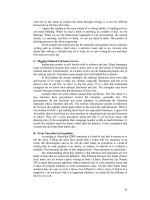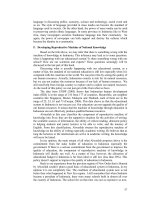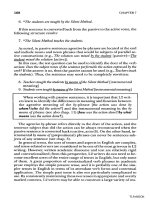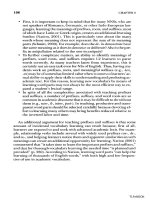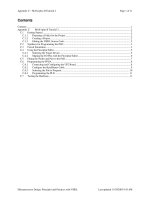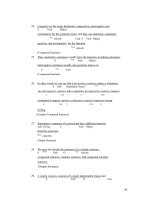Tài liệu Teaching and learning english part 2 ppt
Bạn đang xem bản rút gọn của tài liệu. Xem và tải ngay bản đầy đủ của tài liệu tại đây (408.86 KB, 7 trang )
8
requires (Thomas, 1995). Actually, we have no reason to believe that Eko is being
deliberately uncooperative (i.e., that he is failing to observe the CP). We may conclude
that his failure to observe the maxim of Quantity is due to his wish to observe the CP in
some other way.
As we have seen, Grice’s explanation for the non-observance of the maxim of
Quantity in this instance is that the speaker was faced with a clash of maxims. In this
instance, Eko found himself unable simultaneously to observe the maxims of Quality
and Quantity, which signaled his dilemma by flagrantly failing to give the right amount
of information and prompted his interlocutor to look for an implicature.
Flouting maxim of manner can be seen in the excerpt of dialogue 17:
Meutia: As the head of the party’s executive committee, you should …
Priyo: If the president decides that, then we must respect his decision, because it’s his
choice. Our internal meetings have agreed as much and this was further clarified
to us by Pak Kalla. We are currently focusing on why our popularity has fallen in
the opinion polls. If Golkar gets more seats on the cabinet, that’s great. If not,
then that’s the president’s decision.
In this dialogue, Prio’s answer is not perspicuous in responding the question.
Prio could simply have replied: “I should… or I will …” His actual response is
extremely long-winded and convoluted and it is obviously no accident, nor through any
inability to speak clearly, he is not briefly answering the question that he has flouted the
maxim of manner. In this discussion we can also identify when the maxim of quality is
flouted as the following (see the appendix dialogue 19):
Meutia: Just as long as you don’t get less cabinet posts than the three you have at the
moment?
Priyo: Well, that really would be too much if we got fewer seats! If we got more seats,
that would be great. If we didn’t get any more, well ok, that’s ok. But
I think the
president has already thought long and hard about this. Because until now,
Golkar has been one of the key parties that has supported his administration.
In the above dialogue, we can observe that Prio flouted the maxims of quality.
According to Thomas (1995), flouts which exploit the maxim of quality occur when the
speaker says something which is blatantly untrue or for which he or she lack adequate
evidence. In the above dialogue, Prio can not decide for sure whether his explanation is
true or not. When he use the words
I think , It shows that he can not give adequate
evidence for his statement.
9
5. Summary
In actual conversations, Grice’s four basic maxims of the cooperative principle
are often unobserved or flouted. However, this does not mean that the CP is abandoned.
In Grice’s analysis, the speaker’s flouting of a maxim combined with the hearer’s
assumption that the speaker has not really abandoned the CP leads to an implicature.
Besides flouts necessitated by a clash between maxims, which I have dealt with here,
there are flouts which exploit a maxim while flouting a maxim, the speaker prominently
upholds another maxim in order to be cooperative in the communication. In this
analysis, I argue that the step-by-step reasoning rigor of the CP and its maxims is worth
being inspected by linguists in general and pragmaticists in particular.
References:
Grice, P, 1989, Grice’s Cooperative Principles [online] ssical
dressage.com/zen/articles/a_2.html.[Mei 30, 2007)
Leech, G. N. 1983,
Principles of Pragmatics [M]. New York: Longman Group Limited.
Levinson, S. C. 1983,
Pragmatics [M]. Cambridge: Cambridge University Press.
Thomas, J. 1995,
Meaning in Interaction: an Introduction to Pragmatics [M]. London
and New York: Longman Group Limited.
Yule, G.1996,
Pragmatics. New York: Oxford University Press.
10
Speaking Activities Implemented by
Senior High School Teachers in Classroom
Muhammad Sukrianto
Indonesia University of Education
ABSTRACT
It is widely argued that the success of using a language especially second and foreign
language in real life situation can be determined through speaking. Speaking activities
which are given by a teacher in classroom are the external factor that crucial in
determining speaking achievement of students (Jones 1981; Nunan 1991). Hence, the
study reported here has addressed the questions of what activities implemented by
senior high school teachers in speaking class and why they prefer to implement the
certain activities to the others. This descriptive study employed questionnaires to
obtain the data. The subjects were English teachers of Religion Affairs (DEPAG) who
are taking graduate program at Indonesia University of Education (UPI) in academic
year 2007/2008. The data were analyzed by employing descriptive statistic to find the
frequencies and the percentage of teachers’ answer for each speaking activity. In
classifying the data, there were three categories: positives, abstain, and negative
category. The result shows that the most preferred speaking activity was
Answering the
question orally
(73, 4%), the second were Performing a dialogue (66, 6%) and then
Introducing self to the class (50, 0%) and Expressing opinion orally (50, 0%). These
activities were preferred because they are simpler and easier to conduct. More than
50% gave negative responses toward
Debating (10, 0%) and Interview (23,3%. These
activities were regarded as not-preferred speaking activities, because these activities
are not easy to conduct and need more preparation.
Key Words: Speaking Activities, Senior High School Teachers, Classroom interaction
INTRODUCTION
It has long been recognized that speaking skill is very important in learning a
language, since the success of using a language especially second and foreign language
in real life situation can be measured through speaking. For example, someone can be
told that he or she is capable of speaking English if he or she is able to show his or her
English by practicing it through speaking. Finochiaro (1974) claimed that speaking is a
real language, which means that the capability to communicate in a language can be
shown through the skill of speaking.
The skill of speaking refers to the students’ ability to express mind or feeling
orally. One function of speaking is to communicate ideas in situation where the other
person is listening to words and can be in front of the speaker, looking at the gesture
and facial expression. In other words, we can say that speaking is the skill or capability
to deliver messages directly.
Concerning with the speaking activities, as a matter of fact, in learning English,
most students are reluctant to speak. Puspita and Mulyadi (1991; 31) state that the most
difficult part of the task of the teachers in the teaching English especially in speaking
class laid on how to encourage students to speak. The student seems often reluctant to
speak when they involved in speaking class activities. The same problem also uttered by
Chastain (1976) that many of the EFL students are self conscious and do not like to
make mistake or appear stupid in front of their friends.
Why are the students reluctant to speak English? Actually there are several factors
determine it. Some of them are motivations, needs, attitudes, and students learning style
11
which are called internal factors. The other factor is external factor, such as
environments, family, teacher and learning process in the class.
Speaking activities which are given by a teacher in classroom are argued as
external factor that crucial in determining speaking achievement of students. Jones
(1981) claims that appropriate work activities solve the problems of learners who are
reluctant to speak. It means that if a teacher can provide appropriate and effective
speaking activities, he or she may be able to attract students’ interest to learn more
seriously and self motivated to optimize their learning out comes. Nunan (1991: 39)
states that the learners will be facilitated to speak when they are actively engaged in
attempting to communicate.
Based on all these description, this study attempted to identify the kinds of
speaking activities implemented by teachers in classroom and the reasons of why they
prefer to implement the certain activities to others. It takes a case study on English
teachers of DEPAG who are taking graduate program at UPI in academic year
2007/2008.
THEORETICAL FOUNDATION
Hawes (1994) reveals that most of EFL teachers have often complained about
their learners, because they often do not pay attention to the instruction even reluctant to
participate actively in speaking class. Actually there are some factors influenced, one of
them is the activities which are provided by teachers in classroom. Brown (1994:266),
states that the activities which are given by teachers may attract students’ motivation to
involve in speaking class.
Speaking activities which are applied by teacher and students in a classroom is
crucial to improve their ability in speaking and to avoid the reluctance happens.
According to Chastain (1976), speaking competence can not be achieved in a year or
even two but given the appropriate classroom activities, one has hypothesize that many
students can learn to communicate about those topics covered in their texts. He also
claims that activities in the class can provide the student with opportunity to
communicate in the target language. More over the activities that involve students
feeling and attitude may give them the satisfaction of expressing themselves.
There are many activities can be used by a teacher and students in a speaking
class. In general the activities are divided into three; individual work activity, pair work
activity, and group activity. However Littlewood (1981) divide the stages of activities:
1) Pre-communicative activities, they are structural activities which focus on drilling on
language function, and semi communicative activities, providing social context of how
to use language functions; 2) Communicative activities, they are functional
communication, providing social situation to practice language function and social
interaction activities focusing on real social to practice and internalize language
function in appropriate social context.
In selecting speaking activities, the teachers must always remember that the goal
is for the students to be able to interact freely with others; to understand what other with
to speak in the broadest sense, and to be able to convey the others what they themselves
wish to share. Rivers (1978-47) states that the students need the situation where they are
on their own (that is not supported by teacher or structured exercise) trying to use the
foreign language to exchange with others of real interest to them. The teacher can not
send the students off in group or pairs and tell them to speak. Motivation to speak must
be aroused in some way. The teacher should propose or encourage the students to
12
develop activities which have an intrinsic interest for them. According to Rivers (1978)
the activities in such natural interaction contexts as the following:
1. Establishing and maintaining social relations,
2. Hiding one’s reactions,
3. Expressing one’s intentions,
4. Talking one’s way out of trouble,
5. Seeking and giving information,
6. learning or teaching others to do or making something,
7. Conversing over telephone,
8. solving problem
9. discussing ideas,
10. playing with language,
11. acting social roles,
12. Entertaining others,
13. Displaying one’s achievements,
14. Sharing leisure activities,
The types of interaction activities can lead the students themselves to various
pattern of individualization, with students naturally seeking out partners with whom
they feel at ease. Maslow in Rivers (1978-48) has shown that each individual has
hierarchy of need for feeling of security, belongingness, and self realization.
Some other supporting activities argued may enhance students’ speaking skills
that can be carried out in classroom are role play, games. Tomkins (1998) argues that
role play activity can encourage students’ thinking and creativity. Students usually find
role playing enjoyable, but students who lack self-confidence or have lower proficiency
levels may find them intimidating at first In role plays, students are assigned roles and
put into situations that they may eventually encounter outside the classroom. Because
role plays imitate life, the range of language functions that may be used expands
considerably. Also, the role relationships among the students as they play their parts call
for them to practice and develop their sociolinguistic competence. They have to use
language that is appropriate to the situation and to the characters.
Game is also argued may enhance and motivate students to speak. Games help the
teacher to create contexts in which the language is useful and meaningful. The learners
want to take part and in order to do so must understand what others are saying or have
written, and they must speak or write in order to express their own point of view or give
information. Games are highly motivating because they are amusing and interesting.
They can be used to give practice in all language skills and be used to practice many
types of communication. There are many advantages of using games. Games can lower
anxiety, thus making the acquisition of input more likely. They are highly motivating
and entertaining, and they can give shy students more opportunity to express their
opinions and feelings. They also enable learners to acquire new experiences within a
foreign language which are not always possible during a typical lesson. (Wright 1984,
Ersoz 2000)
All of the activities suggested will obviously not be possible for all students from
the earliest stage of learning. The teacher will select the effective and appropriate ones
to make them practice to speak.
13
METHODOLOGY
The study aims to describe kinds of speaking activities implemented by senior
high school teachers in classroom. It concerns with the existing condition, opinion that
are held and processed that are going on. Therefore this study is conducted through the
application of the descriptive method. This method seems suitable to present the facts
related to the problems which are going to discuss (Silverman, 2005).
The subjects were all senior high school teachers of DEPAG (30 teachers) who
are taking graduate program at UPI in academic year 2006/2007. In this case, the study
uses total sampling, since all the population is taken to be sample.
A set of questioner was used to collect the data of speaking activities implemented
by teachers in classroom. To know their preference, the questionnaire was in the form of
Likert scale (Arikunto, 1999). The options for each activity are
always, often,
sometimes, seldom,
and never. In answering the questions the teachers circle one of the
options that they prefer to apply and than they write the reason of their answer in the
given blanks
The data were then analyzed by calculating teachers’ answers and grouping them
into three;
positive responses, abstains, and negative response. Positive responses were
analyzed by calculating the teachers’ answer in option a (always) and option b, (often)
for each item. If they circle these options, it means that the teachers frequently apply the
activities. Abstains were analyzed by calculating the teachers’ answer in option c
(sometimes) it means that their answers could not be classified into positive or negative
responses. It also means that the researcher can not decide whether they prefer to apply
the activities or not. If the teachers circle on option d (seldom) and option e (never), it
means that they do not prefer to apply the activities so this group we call negative
response.
Since this research is a descriptive study, the teachers’ answers were analyzed by
using descriptive statistic. The data was tabulated in the table to show the frequencies
and the percentage of the teachers’ to each speaking activity. From the table the
researcher found out the highest and lowest rating of speaking activities which are
preferred to teach by the senior high school teachers of DEPAG who are taking graduate
program at UPI in academic year 2007/2008 in their speaking class. In analyzing the
data, the researcher used computer program of SPSS 1.0.
FINDINGS AND DISCUSSION
Data concerning teachers’ preferred speaking activities have shown that the
majority of respondents (39, 8%) are of positive categories, followed by those at
abstains categories (31,6%), then by those at negative category (28,5%). The average
percentage indicated that the different of responses among positive, abstain, and
negative are not too significant. There is no of each category which has the average
percentage score more then a half or upper 50% (see table 1). It means that we can not
say that most of teachers have positive responses toward the speaking activities.
As seen in table 1,
answering the question orally (no.3) was regarded as the most
preferred speaking activity applied by teachers in classroom. 22 out of 30 respondents
or 73, 4% (the highest score) gave positive responses to this speaking activity. Other
activities that regarded as favorable activities were
Performing a dialogue (66,6%) and
then
Introducing self to the class (50,0%) and Expressing opinion orally (50,0%). These
14
activities are regarded as favorable activities since the responses toward theses activities
reach 50% or more (Azwar, 1988). It means that a half or more of respondents preferred
to apply these activities in the classroom.
Meanwhile, speaking activities such as
Debating and Interview were regarded as
not-preferred speaking activities, because more than 50% gave negative responses
toward these activities. 21 out of 30 respondents or 70% (the highest score) gave
negative response toward
Debating activity and 18 out of 30 or 60% gave negative
responses toward
Interview activity (see table 1).
The others speaking activities can not be decided whether the activities are
preferred to implement or not, because the percentage of responses are not more than
50% gave positive or negative responses.
Table 1 Percentage and frequencies of preferred speaking activities
Number of Responses
No Speaking Activities
Positives Abstains Negatives
1 Giving speech 33,3% (10) 36,7% (11) 30,0% (9)
2 Retelling the story from text 33,3% (10) 33,3% (10) 33,3% (10)
3 Answering the question orally 73,4% (22) 13,3% (4) 13,3% (4)
4 Expressing opinion orally 50,0% (15) 26,7% (8) 23,3% (7)
5 Seeking and giving information 40,0% (12) 36,7% (11) 23,3% (7)
6 Describing pictures 33,3% (10) 36,7% (11) 30,0% (9)
7 Role play 43,3% (13) 33,3% (10) 23,3% (7)
8 Introducing self to the class 50,0% (15) 26,7% (8) 23,3% (7)
9 Introducing someone to the class 30,0% (9) 36,7% (11) 33,3% (10)
10 Presenting a report / paper to the class 40,0% (12) 23,3% (7) 36,7% (11)
11 Interview ( interviewing for a job, etc) 23,3% (7) 16,7% (5) 60,0% (18)
12 Performing a dialogue 66,6% (20) 26,7% (8) 6,6% (2)
13 Playing games 40,0% (12) 46,7% (14) 13,3% (4)
14 Problems solving 30,0% (9) 50,0% (15) 20,0% (6)
15 Reporting group result to the class 43,3% (13) 33,3% (10) 23,3% (7)
16 Performing a short talk 36,7% (11) 40,0% (12) 23,3% (7)
17 Debating 10,0% (3) 20,0% (6) 70,0% (21)
Sum 203 161 146
Averages 11,94 9,47 8,58
Percentage 39,8% 31,6% 28,6%
Based on the objective of this study, the teachers responded not only their
preference to speaking activities but also the reasons why they prefer certain activities
to others. As seen in the finding data concerning teachers’ preferred speaking
activities, we can see that the majority of respondents (39,8%) are of positive categories,
followed by those at abstains categories (31,6%), then by those at negative category
(28,5%). Some reasons arouse why the teachers have positive responses or preferred to
implement certain activities compare other activities. Actually the reasons given by
teachers are varies, for examples because the activities are easier to conduct, more
interesting, freer, challenging, and motivating and so on.
Speaking activity of
answering the question orally was regarded as the most
preferred activities applied by in the classroom. 73, 4% (the highest score) of the
respondents gave positive responses to this speaking activity. There are some reasons
why most of the teachers frequently use this activity, for examples, it can be done
anytime; it can encourage the students to speak; it is easier to do, etc. However, mostly
the teachers frequently implement this activity, because it is simple and easy to do.
Other activities that regarded as favorable activities were
Performing a dialogue
(66,6%) and then Introducing self to the class (50,0%) and Expressing opinion orally
(50,0%). These activities are regarded as favorable activities since the responses toward
theses activities reach 50% or more. Based on the finding, the reasons were also varies,

